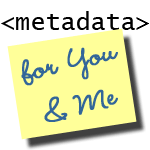Metadata for You & Me - Defining Shareable Metadata: Foundations
Module Content
Screencast
Powerpoint Slides and Other Resources
- Download PowerPoint
- Bruce, Thomas R. and Diane I. Hillmann (2004). "The Continuum of Metadata Quality: Defining, Expressing, Exploiting." Metadata in Practice , ed. Elaine Westbrooks. Chicago, American Library Association.
- Caplan, Priscilla. (2003) Metadata Fundamentals for All Librarians. Chicago : American Library Association.
- Lagoze, Carl. (January 2001) Keeping Dublin Core Simple: Cross-Domain Discovery or Resource Description? D-Lib Magazine 7, no. 1.
- Elings, Mary W. and Günter Waibel (2007). "Metadata for All: Descriptive standards and metadata sharing across libraries, archives and museums." First Monday 12, no. 3.
Module Text
1. What is shareable metadata?Before we talk about qualities individual records should have to be "shareable," we'd like to introduce a set of high-level features that shareable metadata should possess.
Shareable metadata, therefore:
- Is quality metadata
By quality metadata, we do not mean perfect metadata, but metadata that meets the quality standards outlined by Thomas Bruce and Diane Hillmann in their 2004 book chapter "The continuum of metadata quality: defining, expressing, exploiting," in Metadata in Practice . Bruce and Hillmann outline seven metrics for quality metadata: completeness, accuracy, provenance, conformance to expectations, logical consistency and coherence, timeliness, and accessibility. We expand on some of these in our additional characteristics of shareable metadata. - Promotes search interoperability
Priscilla Caplan, in her book, Metadata Fundamentals for All Librarians , describes search interoperability as "the ability to perform a search over diverse sets of metadata records and obtain meaningful results." The most important part of this definition is the focus on obtaining meaningful results. To be truly interoperable, an aggregated search must be able to provide some harmonization of widely differing practices and present to the user coherent results. - Is human understandable outside of its local context
Your records should be self-explanatory when viewed in the context of a third-party aggregation together with records from other institutions, and not rely on any information provided by your local system to make sense to a human user. - Is useful outside of its local context
Your record standing on its own in an aggregation should help the aggregator build advanced services, for example, by including machine-readable geographic information so that a mapping service could be built on top of them, or by including machine-readable dates that could be used to generate a graphical timeline. - Preferably is machine processable
While today's environment doesn't require that shared metadata be completely machine processable, taking action to ensure data elements useful for browsing and search limiting, such as types of resources, dates, and languages, are in machine-processable forms assists an aggregator in providing robust discovery services and helps to ensure your records show up when users make use of browsing and limiting features.
It can be hard to think about authoring metadata that is going to work both in your local environment and that can be shared. What might be useful is to think about metadata as a view of a resource. Carl Lagoze introduces this idea in his 2001 paper on Dublin Core:
Metadata is not monolithic. Instead, it is helpful to think of metadata as multiple views that can be projected from a single information object. Such views can form the basis of customized information services, such as search engines. Multiple views - different types of metadata associated with a Web resource - can facilitate a "drill-down" search paradigm, whereby people start their searches at a high level and later narrow their focus using domain-specific search categories... The Mona Lisa may be viewed from the perspective of non-specialized searchers, with categories that are valid across domains (who painted it and when?); in the context of a museum (when and how was it acquired?); in the geo-spatial context of a walking tour using mobile devices (where is it in the gallery?); and in a legal framework (who owns the rights to its reproduction?) (Lagoze, 2001).
What Lagoze points out in his last sentence is that metadata for the same resource might be different depending on use (for example, metadata used in a walking tour) and audience (for example, a non-specialist). Shareable metadata should take into account these two things: use and audience.
When we talk about shareable metadata in later modules, we'll touch on a few factors that can have an effect on how shareable the metadata is. These are:
- Data structure or the metadata format: How you structure your metadata - what format you use - can affect how shareable your metadata is. There may be cases - and we would argue that there are usually cases - when using multiple formats is entirely appropriate. The same resource might be described in an Encoded Archival Description (EAD) in its local context, but the collection-level information might be mapped to MARC for use in the local OPAC and in WorldCat, while a Dublin Core and a MODS record might be created for the collection level information to share via the OAI Protocol for Metadata Harvesting.
- Content standard in use: The use of content standards (such as Anglo American Cataloging Rules 2nd Ed. (AACR2), Cataloging Cultural Objects (CCO), or Describing Archives: A Content Standard (DACS)) is important to creating standard content. However, each content standard casts a distinct view of the resource that is generally reflective of the community from which is arose. For example, AACR2 tends to have a book- or bibliographic-centric view of the universe, while CCO has an art object view. In some cases, content standards include notations or conventions that might not easily be recognized outside of that community (we'll discuss some of these later in the course).
- Vocabulary standard in use: The use of vocabulary is perhaps one of the most obvious ways to affect the view of a resource. For example, if we were to describe Sunday Afternoon on La Grande Jatte by Georges Seurat using Library of Congress Subject Headings, the closest we could get to the description of the style exhibited in the painting is Neo-impressionism (Art) while the Art and Architecture Thesaurus allows us to describe it using the much more specific term Pointillism. The Library of Congress Name Authority File (LCNAF) specifies Michelangelo Buonarroti, 1475-1564 as the authoritative version of Michelangelo's name, while the Union List of Artists Names (ULAN) lists it as Buonarroti, Michelangelo. In both of these cases, there is not a right or wrong vocabulary to use, but the choice should be dependent on the use of the record and the audience for the record.
Elings and Waibel (2007) have an excellent discussion of some of these issues.
So if we think about metadata being a view of a resource, and that the view should change dependent on use and audience, we can begin to think about what that might mean when we're sharing metadata records. It is worth mentioning here that the different views might be static records or created on the fly.
The following image is another way to think about metadata as a view - if you can
think about the shared versions are facets of the local view of the resource. 
The next several modules in Metadata for You & Me will introduce a framework we call the "Cs and Ss of shareable metadata." Here is a basic summary of this framework:
- Content
- Coherence
- Context
- Communication
- Consistency
- Conformance to Standards
As you can see, there are six Cs in this framework, and there are many Ss for standards in the final C. We'll now proceed to talk about each of these in turn.
Next module: Defining Shareable Metadata: Content



